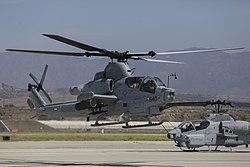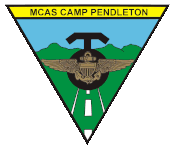Marine Corps Air Station Camp Pendleton or MCAS Camp Pendleton (ICAO: KNFG, FAA LID: NFG) is a United States Marine Corps airfield located within Marine Corps Base Camp Pendleton. It was commissioned in 1942 and is currently home to Marine Aircraft Group 39. The airfield is also known as Munn Field in honor of Lieutenant General John C. "Toby" Munn, the first Marine aviator to serve as the Commanding General of Marine Corps Base Camp Pendleton.
| Marine Corps Air Station Camp Pendleton | |||||||||||||||||
|---|---|---|---|---|---|---|---|---|---|---|---|---|---|---|---|---|---|
Munn Field | |||||||||||||||||
| Part of Marine Corps Base Camp Pendleton | |||||||||||||||||
| Near Oceanside, California in United States | |||||||||||||||||
 A U.S. Marine Corps AH-1Z Viper light attack helicopter taking off from MCAS Camp Pendleton in 2016 | |||||||||||||||||
 | |||||||||||||||||
| Coordinates | 33°18′04″N 117°21′19″W / 33.30111°N 117.35528°W | ||||||||||||||||
| Type | Marine Corps air station | ||||||||||||||||
| Site information | |||||||||||||||||
| Owner | Department of Defense | ||||||||||||||||
| Operator | United States Marine Corps | ||||||||||||||||
| Controlled by | 3rd Marine Aircraft Wing | ||||||||||||||||
| Condition | Operational | ||||||||||||||||
| Website | www | ||||||||||||||||
| Site history | |||||||||||||||||
| Built | 1942 | ||||||||||||||||
| In use | 1942 – present | ||||||||||||||||
| Garrison information | |||||||||||||||||
| Current commander | Colonel Christine M. Houser | ||||||||||||||||
| Garrison | Marine Aircraft Group 39 | ||||||||||||||||
| Airfield information | |||||||||||||||||
| Identifiers | ICAO: KNFG, FAA LID: NFG, WMO: 722926 | ||||||||||||||||
| Elevation | 23.7 metres (78 ft) AMSL | ||||||||||||||||
| |||||||||||||||||
| |||||||||||||||||
| Other airfield facilities | Helicopter rinse facility | ||||||||||||||||
| Source: Federal Aviation Administration[1] | |||||||||||||||||
History
editOn 25 September 1942, the area presently known as Marine Corps Air Station, Camp Pendleton, California was designated an auxiliary landing field and served as a sub-unit of Marine Corps Air Station El Toro.[2] The airfield was 6,000 ft by 400 ft and began operating in November 1942. In February 1944, it became an Outlying Field (OLF) to Marine Corps Auxiliary Field Gillespie and it was during this time that the first squadrons were actually assigned to the field. Among the first squadrons were VMO-5, VMF-323 and VMF-471. In September 1944, the field was designated as a permanent establishment. In 1945, due to overcrowding at Marine Corps Air Station El Centro, Marine Aircraft Group 35 began parking its spare transport planes at the field as well.[3]
During the early 1950s, the airfield was used in filming The Flying Leathernecks starring John Wayne.
Marine Observation Squadron FIVE (VMO-5), a composite squadron consisting of both OV-10 Bronco fixed-wing aircraft and UH-1 Huey helicopters, was established in 1966 and was the first squadron stationed at the airfield following World War II.
Through the years, aviation began to play an increasing role in Marine Corps tactics, creating a need for modern facilities. To meet this need, the auxiliary landing field was re-designated a Marine Corps Air Facility (MCAF) on 1 September 1978 serving as home to Marine Aircraft Group 39 (MAG-39). Since 1978, the Group expanded to a strength of four tactical helicopter squadrons, one helicopter training squadron, one observation squadron, and an aviation logistics squadron. This increase in aircraft and personnel established once again the need for improved facilities.
On 13 March 1985, MCAF Pendleton was re-designated as Marine Corps Air Station effective 1 April 1985. Today, the Air Station supports over 180 helicopters assigned to MAG-39, Marine Aircraft Group 46 Detachment A, and a wide variety of other Marine Corps units and visiting aircraft from other branches of the Armed Forces. The closure of MCAS Tustin and MCAS El Toro were a result of Base Realignment and Closure legislation which saw MCAS Camp Pendleton expand its facilities again to support three additional helicopter squadrons. The first medium lift helicopter squadron joined MAG-39 in January 1999, and the final one came in June of that year.
In July 2020, the station's Headquarters and Headquarters Squadron became a flying unit for the first time when it received a UC-12W Huron. The aircraft is used in the operational support role, allowing high priority passengers and cargo to be flown at a reduced cost compared to using the MV-22B Osprey or UH-1Y Venom.[4]
Based units
editFlying and notable non-flying units based at MCAS Camp Pendleton.[5][6]
United States Marine Corps
editMarine Corps Installations – West
- Marine Aircraft Group 39
- Headquarters Squadron 39 (MAG-39 HQ)
- Marine Aviation Logistics Squadron 39 (MALS-39)
- Marine Light Attack Helicopter Squadron 169 (HMLA-169) – AH-1Z Viper and UH-1Y Venom
- Marine Light Attack Helicopter Squadron 267 (HMLA-267) – AH-1Z Viper and UH-1Y Venom
- Marine Light Attack Helicopter Training Squadron 303 (HMLAT-303) – AH-1Z Viper and UH-1Y Venom
- Marine Light Attack Helicopter Squadron 369 (HMLA-369) – AH-1Z Viper and UH-1Y Venom
- Marine Light Attack Helicopter Squadron 367 (HMLA-367) - AH-1Z Viper and UH-1Y Venom
- Marine Light Attack Helicopter Squadron 469 (HMLA-469) – AH-1Z Viper and UH-1Y Venom
- Marine Light Attack Helicopter Squadron 775 (HMLA-775) – AH-1W Super Cobra, AH-1Z Viper and UH-1Y Venom
- Marine Medium Tilt-rotor Squadron 164 (VMM-164) – MV-22B Osprey
- Marine Medium Tilt-rotor Squadron 364 (VMM-364) – MV-22B Osprey
- Marine Aircraft Group 41
See also
editReferences
edit- Notes
This article incorporates public domain material from websites or documents of the United States Marine Corps.
- ^ "Airport Diagram – Camp Pendleton MCAS (Munn Field) (KNFG)" (PDF). Federal Aviation Administration. 21 May 2020. Retrieved 13 June 2020.
- ^ O'Hara (2005): 95
- ^ Shettle (2001): 84
- ^ Cortez, Lance Cpl. Andrew (6 August 2020). "Making history: H&HS becomes a flying squadron". United States Marine Corps. Retrieved 6 August 2020.
- ^ Kaminski, Tom (2019). "Aircraft of the US Marine Corps". US Navy & Marine Corps Air Power Yearbook 2019. Key Publishing. pp. 93–99.
- ^ "MAG-39". 3rd Marine Aircraft Wing. US Marine Corps. Retrieved 15 June 2020.
- Bibliography
- "History - MCAS Pendleton". MCAS Pendleton, United States Marine Corps. Archived from the original on 3 February 2007. Retrieved 9 February 2007.
- O'Hara, Thomas (2005). Images of America - Camp Pendleton. Charleston, SC: Arcadia. ISBN 0-7385-2982-6.
- Shettle Jr., M. L. (2001). United States Marine Corps Air Stations of World War II. Bowersville, Georgia: Schaertel Publishing Co. ISBN 0-9643388-2-3.
- Web
External links
edit- MCAS Camp Pendleton's official website
- Marine Corps Community Services at Camp Pendleton
- Camp Pendleton at GlobalSecurity.org
- USMC Air Station Camp Pendleton Overview & PCS Information (MarineCorpsUSA.org)
- FAA Airport Diagram (PDF), effective October 31, 2024
- Resources for this U.S. military airport:
- FAA airport information for NFG
- AirNav airport information for KNFG
- NOAA/NWS latest weather observations
- SkyVector aeronautical chart for KNFG
- Airport information for KNFG at Great Circle Mapper.
